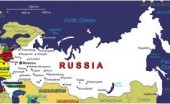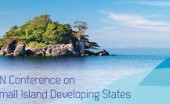Re Ian Bremmer 'Could third-party candidates upend the 2024 US election?' 3 April The current political movement in the USA…
Land, Water And Conflict
Written by Diana Thebaud Nicholson // September 15, 2010 // Water // 1 Comment
The TWO Analysis – Introducing a Methodology for the Transboundary Waters Opportunity Analysis . The report details an analytical framework for effectively developing transboundary water resources in a responsible manner and outlines an approach by which transboundary water stakeholders can collaborate on the equitable and sustainable use of their jointly held freshwater resources.
The fall of the water
(UNEP/IUCN 2004) Emerging threats to the water resources and biodiversity at the roof of the world to Asia’s lowland from land-use changes associated with large-scale settlement and piecemeal development
SciDevNet Spotlight on water security and climate change
Climate change will certainly impact global and regional water resources, but the exact consequences for water security remain unclear. How well can scientists predict the problems? And what can policymakers do to prepare?
Countries dispute use of Nile waters
Nile basin countries are locked in a water supply dispute with Egypt over development projects that would use water from the Nile. Egypt, which relies almost exclusively on Nile waters for its agriculture sector and general water supply, has veto power over any project under a colonial era treaty. Ethiopia, Uganda, Kenya, Tanzania and Rwanda are working to create a new agreement to manage the resource. Los Angeles Times (9/11)
24 May
Chinese engineers propose world’s biggest hydro-electric project in Tibet
Mega-dam on Yarlung Tsangpo river would save 200m tonnes of CO2 but could spark conflict over downstream water supply
… several Chinese hydroengineers see it as the ultimate goal in an accelerating race with India to develop water resources in one of the planet’s last remote regions. Tapping the power of the river as it bends and plunges from the Himalayan roof of the world down towards the Indian and Bangladeshi flood plains has long been a dream of the world’s hydro-engineers.
20 May
To the last drop — How to avoid water wars
(The Economist Special Report on Water) The most hopeful development is the success of other river-basin organisations like the Nile and the Mekong groups. Such outfits now exist for various rivers, including the Danube, the Niger, the Okavango, the Red, the Sava … The way such organisations work, when they work, is to look for the benefits that can be gained from organising water better, and then to share them.
2 May
PERU: Murky Waters Cut Through Andes
(Tierramérica) – The Olmos megaproject, which will divert water from the Huancabamba River through a trans-Andean tunnel to a desert area along Peru’s northern coast, is being touted as a catalyst for development, but disputes are heating up over land, crops and water. In the original plan, there were three phases: diverting the Huancabamba River, which comes from the mountains of the Piura region, through a tunnel under the Andes Mountains; the construction of a hydroelectric complex; and the irrigation of 110,000 hectares in the coastal valley of Olmos.
In the opinion of the Olmos Special Project’s management, it is the cure-all for Peru. The nearly 20-kilometre tunnel under the mountains has been highlighted recently on U.S. television’s Discovery Channel. According to its reports, some 2.5 million cubic metres of water will reach the country’s poorest farmers if the expansion of the initial plan is carried out.
What is certain is that the 38,000 hectares to be irrigated in the first phase do not belong to small or even medium farms.
April 2011
African Hydropower: Damming At What Cost?
(Chatham House | The World Today) The fertile banks of Ethiopia’s Omo river have become the battleground of a struggle between two opposing camps: those who champion the construction of the Gibe III dam on the Omo, focusing on the potential for hydropower to boost Ethiopia’s economic development, and those who feel that the price paid by the Omo’s traditional agro-pastoralist communities would be too devastating to ignore.
7 February
Water at core of climate change impacts-UN experts
(Reuters) – The main impact of climate change will be on water supplies and the world needs to learn from past cooperation such as over the Indus or Mekong Rivers to help avert future conflicts, experts said on Sunday.
Desertification, flash floods, melting glaciers, heatwaves, cyclones or water-borne diseases such as cholera are among the impacts of global warming inextricably tied to water. And competition for supplies might cause conflicts.
But [Zafar Adeel, chair of UN-Water] said that water had often proven a route for cooperation. India and Pakistan have worked to manage the Indus River despite border conflicts and Vietnam, Thailand, Laos and Cambodia have cooperated in the Mekong River Commission.
2010
AFRICA: Drying, Drying, Disappearing…
ROME, Dec 26 (IPS) – Lake Chad was bigger than Israel less than 50 years ago. Today its surface area is less than a tenth of its earlier size, amid forecasts the lake could disappear altogether within 20 years.
Climate change and overuse have put one of Africa’s mightiest lakes in mortal danger, and the livelihoods of the 30 million people who depend on its waters is hanging by a thread as a result. An unprecedented crisis is looming that would create fresh hunger in a region already suffering grave food insecurity, and pose a massive threat to peace and stability, experts say.
“If Lake Chad dries up, 30 million people will have no means of a livelihood, and that is a big security problem because of growing competition for smaller quantities of water,” [said] Dr Abdullahi Umar Ganduje, executive secretary of the Lake Chad Basin Commission (LCBC).
20 October
Melting Himalayan ice prompts conflict fear
As the availability of water declines in Himalayan-fed river systems, researchers expect the India-Bangladesh border to be the first flashpoint of an intensifying battle
A perfect storm of growth, scarcity
The United Kingdom’s chief scientific adviser finds population growth coupled with increased scarcity of resources will lead to a crisis culminating roughly in 2030. By then, the world’s population will have risen from 6 billion to 8 billion, while worldwide demand for food and energy will have increased by 50% and global demand for water will have risen by 30%. BBC (8/25)
Political Power Dictates Transboundary Waters
Since nearly half of the global available surface water is found in 263 international river basins, the countries sharing borders have one of two choices: either collaborate or go to war. The sources of potential collaboration or conflicts include sharing waters in the Baltic Sea, the Jordan River, the Mekong River Basin, the Ganges River, the Indus River and the Nile Valley, among many others. … over 60 percent of the world’s population live in river basins that are shared by two or more countries.
Ban: Act now to avoid climate-related unrest World leaders need to act quickly to reach a global climate deal to decrease the risks violence and social upheaval that will accompany the worsening effects of climate change, United Nations Secretary-General Ban Ki-moon warned. “If we fail to act, climate change will intensify droughts, floods and other natural disasters. … Water shortages will affect hundreds of millions of people. Malnutrition will engulf large parts of the developing world. Tensions will worsen,” Ban said in a prepared statement. AlertNet.org/Reuters (8/11)
India and China co-operate over Himalayan glaciers
(FT) Delhi and Beijing are to co-operate in monitoring the melting of glaciers in the Himalayas, a border region crucial to both countries’ water supplies and one over which they have gone to war
19 July
Bangladesh Ex-PM Asks India to Scrap River Dam Plan
(Reuters/Planet Ark) India has approved plans for a 1,500 megawatt project at Tipaimukh on the Barak River, which flows from northeast India into Bangladesh before emptying into the Bay of Bengal. “We urge upon our neighbor to cancel the dam plan for the sake of millions in both countries who will be adversely affected,” BNP chief Begum Khaleda Zia told a meeting of politicians, experts and activists. Experts warn that the dam could cause two Bangladeshi rivers — the Surma and Kushiara in northeastern Sylhet — to dry up.
14 July
What [does] water scarcity mean for countries and agriculture?
Long-term solutions to water scarcities, supplying water in urban centres and to rural areas require a range of expert knowledge about climate, ecology, farming, population, engineering, economics, community politics, and local cultures says Jeffrey D Sachs, the famous economist who teaches at Columbia University and advises the worldwide governments and US agencies.
Many conflicts are caused or inflamed by water scarcity. The conflicts from Chad to Darfur, Sudan, to the Ogaden Desert in Ethiopia, to Somalia and its pirates, and across to Yemen, Iraq, Pakistan, and Afghanistan, lie in a great arc of arid lands where water scarcity is leading to failed crops, dying livestock, extreme poverty, and desperation.
Extremist groups like the Taliban find ample recruitment possibilities in such impoverished communities. Governments lose their legitimacy when they cannot guarantee their populations’ most basic needs: safe drinking water, staple food crops, and fodder and water for the animal herds on which communities depend for their meagre livelihoods.Politicians, diplomats, and generals in conflict-ridden countries typically treat these crises as they would any other political or military challenge.
As Euphrates dries, need for better water policy intensifies
The Euphrates River is drying up and decimating farms, impoverishing Iraqis who count on the water for their livelihoods and raising anxiety in an already tense region. Persistent drought, and years of misuse and mismanagement are contributing to the problem. The New York Times (7/13)
28 June 2008
As drylands get drier and violence grows, new crises resembling Darfur will arise.
Jeffrey Sachs
(NEWSWEEK) The world will experience a growing risk of conflicts over food, energy and water in coming years. The population rises each year by about 80 million people, with most of the increase in impoverished regions already facing environmental stress. Climate change, water scarcity and tighter oil supplies will add to the stresses. As violence increases, in new crises resembling those now underway in Darfur, Somalia and Afghanistan, the tendency might be to look to the military for solutions. We’ll need to keep in mind that engineers and doctors will be the only ones who can truly keep us safe.
Hundreds of millions of people live on the margin of survival, and their numbers will increase if we continue on our current trajectory. The poorest of the poor tend to be found in remote, environmentally stressed regions, such as the drylands of Africa, the Middle East and Central Asia, which is evident in Yale and Columbia’s Environmental Performance Index. In these places, droughts are becoming more frequent and land more scarce. Rural populations head for the slums in cities unequipped to provide jobs, safe water, sewerage and other basic services.
With a business-as-usual approach, more regions are likely to experience intensifying stresses. Human-induced climate change is predicted to make drylands drier and increase the risk of floods and powerful cyclones in more-humid regions. Increasingly crowded coastal areas will face greater risks of devastating storms. In places that currently rely on groundwater, such as in India, China and the American Southwest, wells will run dry, or become too expensive to drill. And in places in the Andes and in South Asia that depend on the seasonal melting of glaciers for irrigation, these water flows may stop as the glaciers disappear.
The results are unlikely to be pretty. Poor and hungry people are vastly more likely to fall into violent conflict than rich and well-fed populations. And when the climate gets tough, people migrate. Nomads from the drylands of northern Darfur went into the more-humid farm regions of southern Darfur in the 1980s in search of water for their livestock. Similarly, migrants from other parts of the African Sahel, such as Burkina Faso, moved south toward the coastal regions, into the Ivory Coast and other coastal countries. In both cases, the migrations triggered conflicts. Such conflicts are not inevitable. Violence is often stoked by ruthless and demagogic politicians. Still, the environmental crises and ensuing desperation provide the fodder.
Outsiders tend to attribute violence to religion, culture and politics and overlook the underlying causes of water, food and jobs. What some regard as the arc of Islamic instability, across the Sahel, the Horn of Africa, Yemen, Iraq, Pakistan and Afghanistan, is more accurately an arc of hunger, population pressures, water stress, growing food insecurity and a pervasive lack of jobs.
Real solutions will require bold investments in sustainable development. The United States, Europe, China, India and wealthy oil states will have to join forces to help conflict-prone parts of Africa, the Middle East and Asia to raise food output, increase access to education and family planning, and improve productivity through investments in roads, power, irrigation and telecommunications. To head off even more devastating climate shocks in coming decades, we must also end the deadlock over climate-change policy. In water-stressed and conflict-prone regions, technology such as drought-resistant crops, solar-thermal power and drip irrigation can underscore our common fate and interests on an increasingly crowded and crisis-prone planet.
20 August 2007
Warming Will Exacerbate Global Water Conflicts
At Stanford University, Stephen Schneider, editor of the journal Climatic Change and a lead author for the authoritative Intergovernmental Panel on Climate Change (IPCC), says the future is clear.
“As the air gets warmer, there will be more water in the atmosphere. That’s settled science,” he said. But where, and when, it comes down is the big uncertainty.
“You are going to intensify the hydrologic cycle. Where the atmosphere is configured to have high pressure and droughts, global warming will mean long, dry periods. Where the atmosphere is configured to be wet, you will get more rain, more gully washers.
“Global warming will intensify drought,” he says. “And it will intensify floods.”
According to the IPCC, that means a drying out of areas such as southern Europe, the Mideast, North Africa, South Australia, Patagonia and the U.S. Southwest.
5 November 2006
One of our favorite suppliers of relevant information also sends this:
For those who want to explore the issue of environmental shocks and political violence in greater depth, here’s a paper by three economists titled “Economic Shocks and Civil Conflict: An Instrumental Variables Approach,” published in the Journal of Political Economy, in which the authors argue that “drought is a reliable predictor of civil war in sub-Saharan Africa“:
Civil wars have gained increasing attention from academics and policy makers alike in recent years (see, e.g., World Bank 2003). This concern is understandable since civil conflict is the source of immense human suffering: it is estimated that civil wars have resulted in three times as many deaths as wars between states since World War II (Fearon and Laitin 2003). A major locus for civil wars in recent years has been sub-Saharan Africa, where 29 of 43 countries suffered from civil conflict during the 1980s and 1990s. In the median sub-Saharan African country, hundreds of thousands of people were displaced from their homes as a consequence of civil war during this period (Sambanis 2001). The long-term burden of disease and disability caused by war likely far outweighs the number of deaths during fighting (Ghobarah, Huth, and Russett 2003).
…In this paper we use exogenous variation in rainfall as an instrumental variable for income growth in order to estimate the impact of economic growth on civil conflict.Weather shocks are plausible instruments for growth in gross domestic product in economies that largely rely on rainfed agriculture, that is, neither have extensive irrigation systems nor are heavily industrialized. The instrumental variable method makes it credible to assert that the association between economic conditions and civil war is a causal relationship rather than simply a correlation. As such, this paper relates to the empirical approaches recently taken by Acemoglu, Johnson, and Robinson (2001) and especially Brunner (2002), who also employ an instrumental variable approach familiar from applied microeconomics in the context of cross-country empirical growth research. Note that the nature of our econometric identification strategy allows us to focus on short-term economic fluctuations that “trigger” conflicts, but it is not as well suited for understanding conflict duration.




One Comment on "Land, Water And Conflict"
land and water are two of the most important thing in this world.This article really makes sense,in explaining the real and important details on the topics that had pointed out in this article.
Thanks for this post!